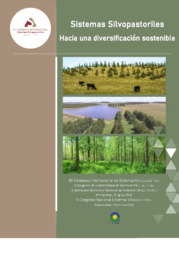Carbon balance of a small dairy farm with integrated livestock-forest system in Goiás, Central West region of Brazil.
Carbon balance of a small dairy farm with integrated livestock-forest system in Goiás, Central West region of Brazil.
Autoria: SIQUEIRA, M. M. B.; CARVALHO, M. T. de M.; CALIL, F. N.; MACHADO, P. L. O. de A.; FERREIRA, C. M.; FREITAS, F. M. C.; RIZZO, P. V.; CAN, E.; RAMSDEN, S.; BARROSO NETO, J.; OLIVEIRA, S. M.; FERNANDES, J. O.; PACHECO, A. R.; MADARI, B. E.
Resumo: The objective of this study was to estimate CO2-eq emissions from milk production and evaluate the potential of integrated livestock-forest system to mitigate emissions via Carbon stocked in soil and eucalyptus trees in Santa Barbara Farm located in the State of Goiás, Central West region of Brazil, within the savanna biome (Cerrado). Tropical soils in the Cerrado are one of the most ancient in the world and therefore long-date weathered. In 2016, integrated livestock-forest system (ILF) was implemented in a pasture on a Geric Xanthic Ferralsol (Dystric Humic). Soil organic C (Corg) stocks in the Ferralsol were around 6 to 7 Mg ha-1 within 0.0-0.3 m layer. In the 4-year old ILF system, there were an extra 0.441 Mg ha-1 Corg stock related to same soil under continuous pasture within 0.0-1.0 m layer. The estimated total emission due to dairy production per year at farm level was around 520 Mg CO2-eq or 142 Mg of C emitted to atmosphere. Most of emissions were related to animal feeding (58%). Considering total Corg stocks in 1-m depth of soil and 2-years old eucalyptus trees in the ILF system, yet the C balance was positive, indicating emission of 102.93 Mg of C to the atmosphere due to the present dairy production system conducted at Santa Barbara farm. At 4 years after implementation, the ILF system was a sink of 38.94 Mg of C from atmosphere, offsetting around 28% of total emissions, a significant number once the farmer intends to keep and increment the ILF area in order to sustain milk production levels due to thermal comfort delivered to the cows by trees.
Ano de publicação: 2023
Tipo de publicação: Artigo em anais e proceedings
Unidade: Embrapa Arroz e Feijão
Palavras-chave: Carbon, Carbono, Cerrado, Compensação, Cool farm tool, Dairy farming, Estoque de Carbono, Eucalipto, Eucalyptus, Floresta, Goiás, Pecuária, Produção Leiteira, Savannas, Sistema integrado, Solo
Observações
1 - Por padrão são exibidas publicações dos últimos 20 anos. Para encontrar publicações mais antigas, configure o filtro ano de publicação, colocando o ano a partir do qual você deseja encontrar publicações. O filtro está na coluna da esquerda na busca acima.
2 - Para ler algumas publicações da Embrapa (apenas as que estão em formato ePub), é necessário ter, no celular ou computador, um desses softwares gratuitos. Sistemas Android: Google Play Livros; IOS: iBooks; Windows e Linux: software Calibre.
Acesse outras publicações
Acesse a Base de Dados da Pesquisa Agropecuária (BDPA) para consultar o acervo completo das bibliotecas da Embrapa.

